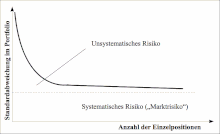Unsystematic risk

Under the unsystematic risk (also specific , idiosyncratic or diversifiable risk ) is understood within the context of portfolio theory and the capital asset pricing model (in short: CAPM ) that part of the risk , by risk diversification of the securities portfolio can be reduced.
General
It is thus opposed to the systematic risk , a residual that cannot be reduced any further (see also market risk ).
The general concept of risk is formally expressed by the variance or standard deviation. The calculation is based on observation data from the past. When determining this risk factor, attention should always be paid to the data on which it is based. It remains unanswered to what extent these quantities are suitable for forecast purposes.
The company-specific risk should not be relevant to the assessment .
Unsystematic risk includes management errors, such as wrong product policy or excessive costs . But also the credit risk with corporate bonds or loans as well as average . In any case, the cause of the risk is always based on the investment itself. It is in contrast to the market risk , which is caused, for example, by a shock , government intervention or a natural disaster.
In the case of unsystematic risk, market participants can optimize their portfolio through skillful risk diversification , so no risk premium is paid here.
Formal representation
In order to clarify the difference between systematic and unsystematic risk, the two classic cases of uncorrelated and correlated securities are examined more closely. In the rare case in reality that there is a negative correlation between the investment options (here a correlation coefficient of −1), the risk can be completely eliminated by building a portfolio. In the realistic case of not perfectly negatively correlated securities, only the unsystematic risk can be eliminated, a remainder will always remain.
Uncorrelated Securities
There are various securities whose respective returns are and are. Their covariance is zero ( ) and the portfolio variance is thus reduced:
.
Here stand for the share that one holds in the respective security. For the sake of simplicity, naive diversification is often arrived at, i. H. An equal proportion is invested in all securities ( ). Then you can write:
The last term describes the average variance of the securities and one writes alternatively:
- . In the limit consideration (for ever larger portfolio) is very large and therefore the variance getting smaller: . In the ideal case, the unsystematic risk of the securities can not only be reduced but also eliminated through a sufficiently large portfolio diversification.
Correlated Securities
In the case of correlated securities, these formulas get a little larger:
The first summand again contains the average variance of all securities and the second summand the average covariance of the same. In abbreviated form can be written:
In the limit value analysis, this means that this average covariance is retained:
- .
Capital market line
The capital market line is a component of the Capital Asset Pricing Model , which is a further development of the portfolio theory . Their central equation also contains the division of the two types of risk:
- .
In this model, the concept of the risk-free interest rate and the so-called beta factor are also taken into account . For a positive beta, the expected return on an investment must be greater than the systematic risk.
Individual evidence
- ↑ Bernd W. Wirtz, Mergers & Acquisitions Management , Springer-Verlag, 2003. p. 50.
- ↑ Henner Schierenbeck, Earningsorientrertes Bankmanagement , Volume 2: Risk Controlling and Integrated Risk Management , 8th edition, Wiesbaden 2003, p. 39
- ↑ Fred Wagner (ed.), Gabler Versicherungslexikon , Springer-Verlag, 2011. P. 673.
- ↑ Bernd R. Fischer, Performance Analysis in Practice , Oldenbourg Verlag, 2001. p. 448.
- ^ Peter Zweifel / Roland Eisen, Insurance economics , Springer Science & Business Media, 2012. P. 127/128.



![{\ displaystyle \ operatorname {Cov} [R_ {i}, R_ {j}]}](https://wikimedia.org/api/rest_v1/media/math/render/svg/d3e941e43c81016d9248527d82d21edfe08f66fb)
![{\ displaystyle \ operatorname {Var} [R_ {P}] = \ sum _ {i = 1} ^ {n} \ alpha _ {i} ^ {2} \ operatorname {Var} [R_ {i}]}](https://wikimedia.org/api/rest_v1/media/math/render/svg/d0b7a6cac3baae98b66b94668dbcecdab03651f1)


![{\ displaystyle \ operatorname {Var} [R_ {P}] = \ sum _ {i = 1} ^ {n} {\ frac {1} {n ^ {2}}} \ operatorname {Var} [R_ {i }] = {\ frac {1} {n}} \ left (\ sum _ {i = 1} ^ {n} {\ frac {\ operatorname {Var} [R_ {i}]} {n}} \ right ).}](https://wikimedia.org/api/rest_v1/media/math/render/svg/ace758e6a4e2dcb3e7fb535dcd6ea6350d469fa6)

![{\ displaystyle \ operatorname {Var} [R_ {P}] = {\ frac {1} {n}} {\ overline {\ operatorname {Var}}}}](https://wikimedia.org/api/rest_v1/media/math/render/svg/8f947ea778e4d110f34eb7c0115dfcb76adf8c21)

![{\ displaystyle \ lim _ {n \ to \ infty} \ operatorname {Var} [R_ {P}] = 0}](https://wikimedia.org/api/rest_v1/media/math/render/svg/9281379de63a8711076223ff41ee9ac2fb374792)
![{\ displaystyle {\ begin {aligned} \ operatorname {Var} [R_ {P}] & = \ sum _ {i = 1} ^ {n} {\ frac {1} {n ^ {2}}} \ operatorname {Var} [R_ {i}] + \ sum _ {i = 1} ^ {n} \ sum _ {j = 1, j \ neq i} ^ {n} {\ frac {1} {n ^ {2 }}} \ operatorname {Var} [R_ {i}, R_ {j}] \\\ operatorname {Var} [R_ {P}] & = {\ frac {1} {n}} \ left (\ sum _ {i = 1} ^ {n} {\ frac {1} {n}} \ operatorname {Var} [R_ {i}] \ right) + {\ frac {n-1} {n}} \ left (\ sum _ {i = 1} ^ {n} \ sum _ {j = 1, j \ neq i} ^ {n} {\ frac {\ operatorname {Cov} [R_ {i}, R_ {j}]} { n (n-1)}} \ right) \ end {aligned}}}](https://wikimedia.org/api/rest_v1/media/math/render/svg/b9b8a8d934f0c81a99c164e63eb7b1b55621ef11)
![{\ displaystyle \ operatorname {Var} [R_ {P}] = {\ frac {1} {n}} {\ overline {\ operatorname {Var}}} + {\ frac {n-1} {n}} { \ overline {\ operatorname {Cov}}}}](https://wikimedia.org/api/rest_v1/media/math/render/svg/7acad0593368b73a3b6452f48827689662b39ec7)
![{\ displaystyle \ lim _ {n \ to \ infty} \ operatorname {Var} [R_ {P}] = {\ overline {\ operatorname {Cov}}}}](https://wikimedia.org/api/rest_v1/media/math/render/svg/c5902e43684b476d01b510836cdeee70d20b908a)
![{\ displaystyle \ operatorname {E} [R_ {i}] = r_ {f} + \ beta _ {i} (\ operatorname {E} [R_ {m}] - r_ {f})}](https://wikimedia.org/api/rest_v1/media/math/render/svg/1ec5676e716cc85459dbd33eac970408e3a62ac3)